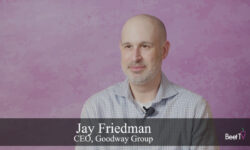During next month’s TV Upfront, AT&T’s Xandr Media will unveil “a big upgrade” for television advertising, a main thrust of which will be the use of ads addressable to devices households to frequency cap and manufacture reach. The company will present at it’s first “Xandr Front” event on May 14.
“There is a need to upgrade the advertising experience,” says Jason Brown, SVP, Head of Ad Sales Partnerships at Xandr Media. He cites such shortcomings as too many irrelevant ads, too much frequency and commercial overload.
At the Xandr Front, “you’re going to hear how we’re using the technology of addressable at scale to solve these issues to create a better advertising experience, to create a better customer experience,” Brown adds in this interview with Beet.TV.
“It’s not a complete reinvention of TV advertising but it’s a big upgrade. This year especially brands are going to want to hear about it.”
The traditional concept of addressability—targeting devices and households and tracking ad outcomes—is getting a “new flavor that’s trending right now, and it’s frankly just the ability to use the technology to frequency cap and manufacture reach and create a better user experience.”
According to Brown, 50% of all national brands use some form of addressable advertising. Typically, they had been brands selling goods or services to less than 35% of the population, but now consumer packaged-goods and other categories have turned to addressable, too.
“They’re typically using the product for reach extension and frequency controlling,” Brown says. Regional brands, particularly “super regionals” like supermarket chains, are also testing addressable.
Automotive and financial services advertisers are “well beyond testing” and the “middle phase” with addressable, wherein a couple of campaigns a year had been the norm.
“Many of them are always on. They’ve realized the light bulb has gone off. They realize the benefits. They’re seeing the ROI around always being in front of their most valuable customers and the ROI it’s delivering for them,” says Brown.
Mass marketers faced with declining linear-TV ratings and “pricing well beyond inflation” are experiencing over-saturation of heavy TV viewers, because 80% of a schedule can reaches only 30% of households “at a very high level of frequency.” Addressable can add a frequency cap.
“When you do that you reach you reach the heavy TV viewer in a couple of days. The ad comes off the system and then it just extends across every decile. You have this kind of even distribution of deciles.”
Given AT&T’s own assets and its deals with Altice USA and Frontier Communications on the local level, “We now represent forty percent of all sellable impressions in the marketplace,” Brown says.














































